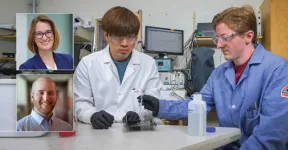(Press-News.org) CHAMPAIGN, Ill. — Understanding how soft materials fail under stress is critical for solving engineering challenges as disparate as pharmaceutical technology and landslide prevention. A new study linking a spectrum of soft material behaviors — previously thought to be unrelated — led researchers to identify a new parameter they call the brittility factor, which allows them to simplify soft material failure behavior. This will ultimately help engineers design better materials that meet future challenges.
University of Illinois Urbana-Champaign chemical and biomolecular engineering professor Simon Rogers and graduate student Krutarth Kamani specialize in determining how soft materials yield to stress and have shown how solid and liquid physical states can exist together in the same material. This area is of high interest due to its importance to industrial, environmental and biomedical applications.
Along the way, the team identified a communication breakdown among the scientists who work in this area, causing a bottleneck between a theoretical understanding of soft material behavior and real-world applications.
When soft materials — natural or synthetic — deform under pressure, they eventually reach a critical point where they either return to their original form or undergo permanent deformation, like stretching or breaking a piece of elastic. This process is known as yielding. A gradual yielding transition is termed ductile behavior, while an abrupt one is referred to as brittle behavior, the researchers said.
“At a recent conference, we realized that all of us who study soft materials from all over Europe and North America couldn’t agree what the connection is between brittle and ductile behavior nor how to define it.”
In the study, published in the Proceedings of the National Academy of Sciences, instead of viewing soft material behavior as one or the other — brittle or ductile — Rogers’ team considers a spectrum of yielding behaviors. This allowed the team to build a continuum model, which led to them uncovering the brittility factor. This factor is critical in determining how and why soft materials fail.
Essentially, brittility affects how a material deforms permanently under stress. The team’s model indicates that the higher the brittility factor, the less a soft material will deform permanently before yielding.
As in the team’s past studies, the model was developed and tested using data from numerous experiments that subjected various soft materials to stress while measuring the individual strain responses using a device called a rheometer.
“We didn’t expect this study to explain as much as it does,” said Rogers, who is also an affiliate at the Beckman Institute for Advanced Science and Technology at the U. of. I. “What we ended up with was a way to bring a whole bunch of soft material behaviors together under the same physics umbrella. Previously, they’d been studied independently or maybe all been applied simultaneously, but never thought of as being physically or mathematically connected.”
This finding will allow researchers to explain precisely why some materials are more resistant to rapid yielding than others, a question that has eluded researchers for decades.
“This single parameter amazingly connects so many puzzling observations researchers have come across over the years,” Kamani said.
“This work marks the point at which we are approaching the crest of the hill in understanding soft materials behavior,” Rogers said. “We’ve always felt like each step takes us higher, but with no end in sight. Now we can see the top of the hill, and we are closer to the top and free to move forward in whatever direction we would like.”
The National Science Foundation supported this research.
Editor’s note:
To reach Simon Rogers, call 217-333-0020; email sarogers@illinois.edu.
The paper “Brittle and ductile yielding in soft materials” is available online. DOI: 10.1073/pnas.2401409121.
Chemical and biomolecular engineering is part of The Grainger College of Engineering.
END
DURHAM, N.C. – The world around us is constantly being flash photographed by adaptive radar systems. From salt flats to mountains and everything in between, adaptive radar is used to detect, locate and track moving objects. Just because human eyes can’t see these ultra-high frequency (UHF) ranges doesn’t mean they’re not taking pictures.
Although adaptive radar systems have been around since World War II, they’ve hit a fundamental performance wall in the past couple of decades. But with the help of modern AI approaches and lessons learned from computer vision, researchers at Duke University have broken through that wall, and they want to bring everyone ...
University of Delaware and Argonne National Laboratory have come up with a chemical reaction that can convert Styrofoam into a high-value conducting polymer known as PEDOT:PSS. In a new paper published in JACS Au, the study demonstrates how upgraded plastic waste can be successfully incorporated into functional electronic devices, including silicon-based hybrid solar cells and organic electrochemical transistors.
The research group of corresponding author Laure Kayser, assistant professor in the Department of Materials Science and Engineering in ...
Leading health equity researcher Darrell Hudson, MPH ‘05, PhD ‘09, has been named chair of the Department of Health Behavior and Health Education at the University of Michigan School of Public Health. His appointment for a five-year term, effective August 26, 2024, was approved by the University of Michigan Board of Regents this week.
“Dr. Hudson has solidified his national reputation as a leading health equity scholar, making impactful research contributions through rigorous, interdisciplinary, and innovative scholarship,” said F. DuBois Bowman, dean of Michigan Public Health. “His research is timely ...
LAWRENCE — Around the globe, communities at risk from repeated flooding due to climate change face stark decisions. Some communities in peril of flooding may resolve, or be urged, to relocate to a safer location — something known as “managed retreat.” In the United States, flood-prone communities in coastal states like Louisiana and Alaska already have commenced managed retreat inland.
“It's retreating from risk, and we hope to provide decision support for the equitable implementation ...
HUNTINGTON, W.Va. – Marshall University was awarded a $3.3 million grant (#R01DA057931) from the National Institute on Drug Abuse (NIDA) to examine the genetic mechanisms that underlie fentanyl addiction.
In 2022, fentanyl overdose was the leading cause of death for U.S. adults aged 18 to 45, according to Families Against Fentanyl (2023).
“This alarming statistic highlights the urgent need to understand why some people are more susceptible to fentanyl addiction,” ...
By Leah Shaffer
Amyloid-beta (A-beta) aggregates are tangles of proteins most notably associated with neurodegenerative diseases like Alzheimer’s. Despite its constant stint in the limelight, however, researchers have been unable to get a good understanding of how A-beta comes together and breaks apart.
“The way A-beta behaves in a variety of environments, including the human brain, is elusive,” said Brian Sun, an electrical systems and engineering alumnus of Washington University in St. Louis who is now an MD/PhD student in the School of Medicine.
“There’s an understanding of growth and decay that isn’t ...
New dawn for space storm alerts could help shield Earth's tech
Royal Astronomical Society press release
RAS PR 24/22 (NAM 8)
For immediate release
Space storms could soon be forecasted with greater accuracy than ever before thanks to a big leap forward in our understanding of exactly when a violent solar eruption may hit Earth.
Scientists say it is now possible to predict the precise speed a coronal mass ejection (CME) is travelling at and when it will smash into our planet – even before it has fully erupted from ...
In 10 years, solid-state batteries made from rock silicates will be an environmentally friendly, more efficient and safer alternative to the lithium-ion batteries we use today. Researcher at DTU have patented a new superionic material based on potassium silicate - a mineral that can be extracted from ordinary rocks.
It is the battery in your electric car that determines how far you can drive on one charge and how quickly you can re-charge. However, the lithium-ion battery, the most widely used electric car battery today, has its limitations— in terms of capacity, safety and also availability. ...
About The Study: In this nested case-control study, completing fecal immunochemical test was associated with a lower risk of overall death from colorectal cancer, particularly in the left colon, and the associations were observed across racial and ethnic groups. These findings support the use of fecal immunochemical test in population-based screening strategies.
Corresponding Author: To contact the corresponding author, Chyke A. Doubeni, M.D., M.P.H., email chyke.doubeni@osumc.edu.
To access the embargoed ...
About The Study: Oral corticosteroid use of more than 90 days per year among individuals with atopic dermatitis was associated with a small increased risk of composite adverse outcomes in this large population-based case-control study. Future investigations are warranted to confirm this potential risk of adverse events (AEs) associated with long-term use of oral corticosteroids for patients with exacerbations of atopic dermatitis, and health care professionals should thoroughly weigh the benefits associated with oral corticosteroids ...







